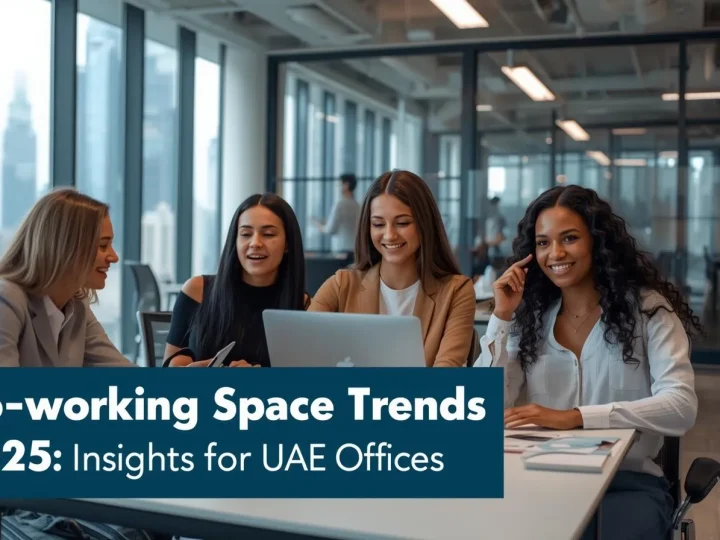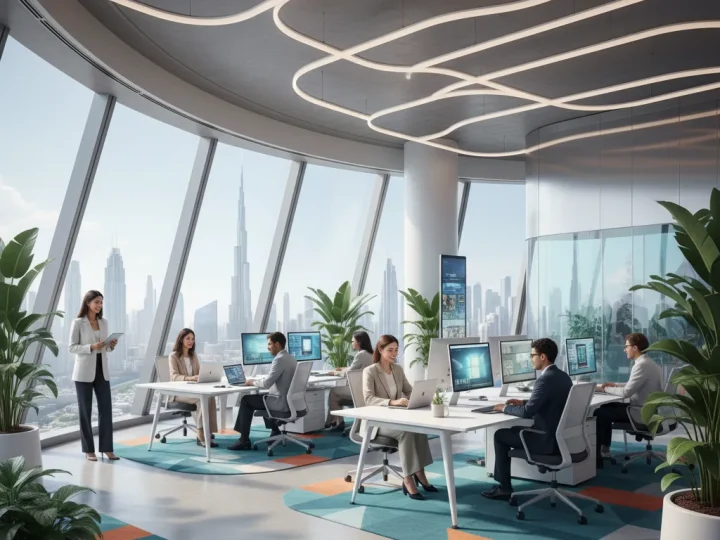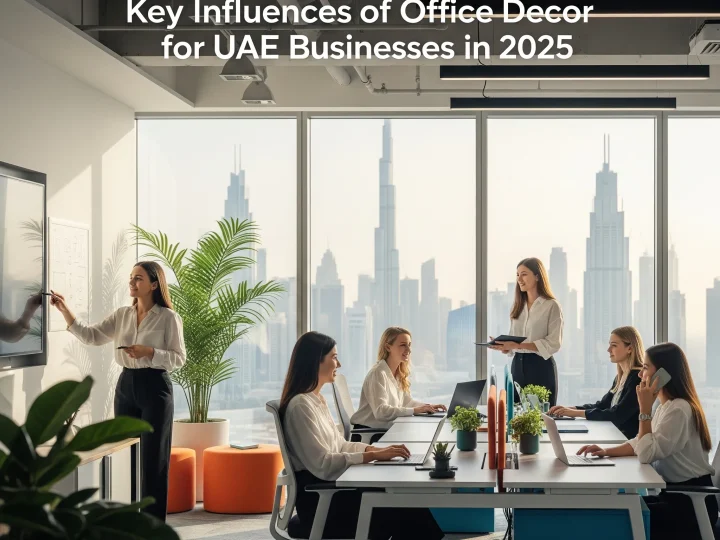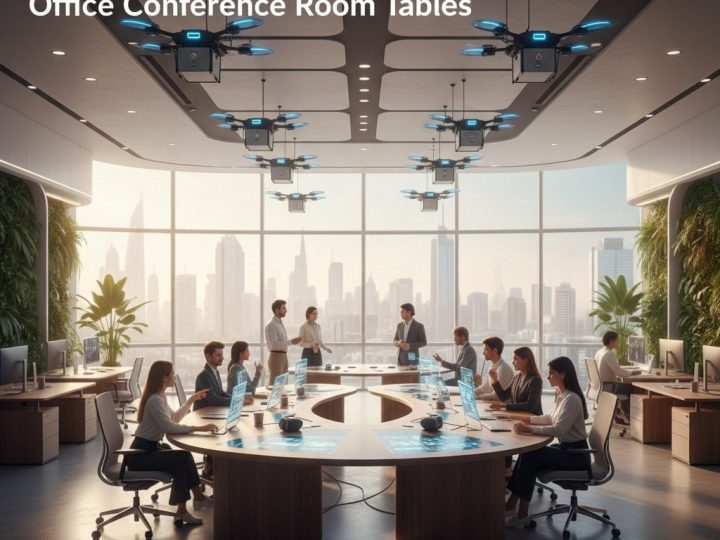

Dubai’s office design is setting new standards in the corporate world. Recent studies show that companies adopting open, collaborative layouts see a 20 percent increase in employee creativity. But hold on for a second. While you might think the slick designs and tech integrations steal the show, they’re not the main star. The real game changer is how these features enhance employee wellbeing and productivity. Discover how modern office trends in Dubai are reshaping the future of work.
Dubai Workspace Layout Trends
Dubai’s business office furniture landscape is evolving fast, with office design that reflects both global developments as well as local cultural variations. Contemporary office design in Dubai today embraces the flexibility of sustainability, flexibility and the wellbeing of employees as primary values, that go far past the cubicle-style layouts that were commonplace in the old.
The Shift Toward Open Collaborative Spaces
One of the most notable patterns of Dubai’s workplace layout is the change from compartmentalized workspaces to collaborative, open workspaces. The change isn’t just about eliminating walls, it’s a major shift in how we work. The modern office layout is available in Dubai is now characterized by strategically-placed spaces for collaboration, informal gathering zones, and multi-functional spaces that can adapt to changes in needs during the day.
The open floor plans facilitate the team to interact in a natural way of different departments, removing the barriers that previously hindered the ability to innovate. Some Dubai-based businesses report increased ability to think critically and solve problems after the introduction of more open floor plans. The most efficient layouts maintain balance by including quieter areas to focus on work that requires a high level of concentration.
Technology-Integrated Environments
Dubai is positioned as a technology center of the world that extends to the workplace design. The modern workplace design of Dubai effortlessly integrates technology into the office. Intelligent building systems regulate lighting as well as temperature and the quality of air based on the patterns of occupancy and preferences of employees. Wireless charging stations and Augmented Reality capabilities are now commonplace features, not luxury items.
What separates Dubai from other cities is how tech elements are made to blend to create visually pleasing spaces. The days are gone of exposed wires and utilitarian technology stations. Technology is now embedded in sleek architectural components that maintain the highly sophisticated aesthetic standard Dubai is famously known for.
Biophilic Design Elements

Despite Dubai’s desert climate, or perhaps because of it, bringing elements of nature into the workplace has become increasingly important. Biophilic design—incorporating natural materials, abundant natural light, living walls, and indoor gardens—addresses the innate human desire to connect with nature. This approach has proven particularly effective in Dubai’s corporate environments, where employees might otherwise spend entire workdays in air-conditioned spaces disconnected from the natural world.
Advanced building techniques now allow for massive window installations that maximize natural light while minimizing heat gain—a crucial consideration in Dubai’s climate. Interior plantscapes serve dual purposes: improving air quality while adding visual relief in corporate settings. The psychological benefits are significant, with employees reporting reduced stress levels and improved cognitive function in biophilic workspaces.
This evolution in workspace design aligns with global trends but maintains uniquely Dubai characteristics. According to research on contemporary office design, workspaces worldwide are shifting toward sustainable, flexible layouts that prioritize employee wellbeing, incorporating features like natural light, noise control, and adaptable furniture systems. This global shift is driven by multiple factors including economic considerations, technological advancements, and lessons learned during the pandemic.
As Dubai continues to cement its position as a leading business destination, its workspace layouts increasingly reflect both international best practices and local innovation—creating environments that support productivity while honoring the emirate’s commitment to being at the forefront of global workplace evolution.
Key Takeaways
| Takeaway | Explanation |
|---|---|
| Embrace Open Collaborative Spaces | Transition from cubicles to open layouts encourages interaction and innovation, while including quiet areas for focus. |
| Integrate Technology Seamlessly | Smart systems for lighting, temperature, and air quality can enhance comfort and efficiency without compromising aesthetic appeal. |
| Adopt Biophilic Design Principles | Incorporating natural elements helps improve employee wellbeing and reduces stress through better connection to nature. |
| Utilize Multifunctional Furniture | Flexible furniture systems can adapt to various tasks and group sizes, enhancing space usability and functionality. |
| Implement Sustainable Design | Focus on energy efficiency, water conservation, and material selection to align with environmental goals and improve workspace quality. |
Innovative Interior & Furniture Ideas
The modern office design landscape in Dubai is witnessing a remarkable transformation through innovative interior and furniture solutions that balance aesthetics, functionality, and employee wellbeing. These cutting-edge approaches are redefining workspace experiences across the emirate’s diverse business sectors.
Multifunctional Furniture Systems
Gone are the days of static, single-purpose office furniture. Dubai’s forward-thinking workplaces now feature multifunctional furniture systems that adapt to different tasks and team configurations. Modular workstations with adjustable components allow spaces to transform from individual work areas to collaborative settings within minutes. These systems typically include movable privacy panels, height-adjustable surfaces, and integrated technology ports.
What makes Dubai’s approach distinctive is the emphasis on both flexibility and sophistication. Multifunctional furniture in Dubai offices often incorporates premium materials like brushed metal, tempered glass, and sustainable wood varieties that reflect the emirate’s reputation for luxury while maintaining practical functionality. These pieces serve as both workplace tools and design statements, elevating the overall aesthetic of the space.
A particularly innovative trend emerging in Dubai is furniture with embedded smart technology. Conference tables with built-in wireless charging, seating with posture sensors that provide feedback through smartphone apps, and desks that track usage patterns to optimize space allocation are becoming increasingly common in premium office environments.
Culturally-Informed Design Elements
Dubai’s position as a global business hub with strong cultural roots has inspired interior design approaches that thoughtfully blend international best practices with local design traditions. Modern office design in Dubai often incorporates geometric patterns inspired by Islamic art, strategic use of colors significant in Emirati culture, and spatial arrangements that respect cultural norms while fostering innovation.
These cultural elements aren’t merely decorative—they create environments that resonate with both local and international employees. Meeting spaces might feature contemporary interpretations of majlis-style seating, encouraging the open exchange of ideas in a setting that feels familiar and respectful to local traditions. Meanwhile, reception areas often showcase striking design features that tell the organization’s story through a contemporary lens influenced by regional artistic expressions.
Smart Space Division Solutions

The challenge of creating distinct zones within open-plan offices has led to incredibly innovative space division approaches in Dubai. Moving beyond standard partition walls, today’s modern office design in Dubai utilizes acoustic furniture pods, plantscape dividers, and intelligent glass systems that can switch from transparent to opaque with the touch of a button.
These solutions address multiple needs simultaneously: providing visual and acoustic privacy when needed while maintaining the benefits of open-plan layouts. Acoustic pods, for instance, create micro-environments for focused work or small-group discussions without requiring permanent structural changes. These self-contained units often feature integrated ventilation, lighting, and technology connections while significantly reducing ambient noise.
According to recent research on smart adaptive spaces, these dynamic environments can significantly improve both space efficiency and personalization, allowing workplaces to adjust to changing needs in real-time through the integration of sensors and responsive systems. The adaptability offered by such technologies is particularly valuable in addressing the evolving demands of today’s workplaces.
As Dubai continues to position itself as a center for business innovation, these furniture and interior design approaches reflect a sophisticated understanding that the physical workplace environment directly impacts organizational performance, employee satisfaction, and brand perception. The most successful implementations balance technological advancement with human-centered design principles, creating spaces that are as intuitive to use as they are impressive to experience.
Smart Tech Integration Strategies
In Dubai’s competitive business landscape, smart technology integration has become a defining element of modern office design. Forward-thinking organizations are moving beyond superficial tech additions to implement comprehensive strategies that enhance productivity, improve user experience, and create truly intelligent workspaces.
Holistic IoT Ecosystems
The most effective modern office design in Dubai now incorporates holistic Internet of Things (IoT) ecosystems rather than disconnected smart devices. These integrated systems connect everything from building management controls to individual workstations through a unified platform. Sensors embedded throughout the workspace collect real-time data on occupancy, temperature, lighting levels, and air quality, allowing for automated adjustments that optimize both energy efficiency and employee comfort.
What distinguishes Dubai’s approach is the seamless integration of these systems within architecturally striking environments. The technology remains largely invisible to users while delivering tangible benefits. For example, meeting rooms automatically adjust lighting and temperature based on occupancy and preferences, while simultaneously updating availability status in booking systems. This holistic approach eliminates technology silos that often plague partial implementations.
The economic benefits of such integrations are substantial. Research shows that comprehensive digital transformation through smart technologies can increase operational efficiency by 8–10 times for businesses across various sectors. This ‘smartification’ process creates opportunities to improve value creation and streamline operations in multiple areas simultaneously.
User-Centered Design Approaches
Dubai’s most successful smart office implementations place user experience at the center of technology decisions. Rather than deploying technology for its own sake, companies are implementing solutions that genuinely enhance how employees interact with their environment. This approach begins with identifying key pain points and workflows before selecting appropriate technological solutions.
Mobile applications that provide personalized control over the immediate work environment have become increasingly common. These interfaces allow employees to adjust lighting, temperature, and even background noise levels in their immediate vicinity. The same platforms often include wayfinding features for navigating large office complexes, desk reservation capabilities for flexible seating arrangements, and communication tools specifically designed for hybrid work scenarios.
The most sophisticated implementations employ artificial intelligence to learn individual preferences over time, creating increasingly personalized environments that anticipate needs before they’re expressed. This user-centered strategy ensures technology serves as an enabler rather than a distraction or complication.
Strategic Implementation and Change Management
Implementing smart technology effectively requires more than purchasing advanced systems. Dubai’s leading organizations recognize that successful integration demands strategic planning and thoughtful change management. This typically involves phased implementation approaches that allow for testing, refinement, and user adaptation before full-scale deployment.
Educational components are essential to this process. Organizations implementing new smart office technologies typically develop comprehensive training programs that demonstrate both how to use new systems and the benefits they provide. This focus on explaining the ‘why’ behind new technology helps overcome resistance to change and increases adoption rates.
The most successful implementations also incorporate feedback mechanisms that allow users to report issues and suggest improvements. This creates a continuous improvement cycle that refines the technology experience over time while giving employees a sense of ownership in the evolving workspace.
As Dubai continues its trajectory as a global innovation hub, these smart technology integration strategies are becoming increasingly sophisticated. The focus has shifted from implementing individual smart devices to creating coherent, user-friendly ecosystems that genuinely enhance the workplace experience. Organizations that approach technology integration strategically—with careful attention to both technical capabilities and human factors—are creating workspaces that offer significant competitive advantages in attraction and retention of talent, operational efficiency, and overall workplace satisfaction.
Sustainable Design For Offices
Sustainability has evolved from a nice-to-have feature to an essential component of modern office design in Dubai. As the emirate pursues ambitious environmental goals, businesses are increasingly incorporating eco-conscious elements that reduce environmental impact while creating healthier, more efficient workspaces.
Energy Efficiency Innovations
Energy efficiency stands at the forefront of sustainable office design in Dubai. The extreme climate creates unique challenges, with cooling systems traditionally consuming enormous amounts of energy. Modern office design in Dubai now addresses this through multiple sophisticated approaches.
Smart glazing technologies that respond to external conditions are becoming standard in new office constructions. These advanced window systems automatically adjust tint levels based on sunlight intensity and angle, significantly reducing heat gain without sacrificing natural light. This technology alone can reduce cooling costs by 20-30% in Dubai’s climate.
Lighting represents another area where substantial efficiency gains are being realized. Beyond simply switching to LED fixtures, today’s sustainable offices in Dubai implement comprehensive lighting strategies. These include daylight harvesting systems that automatically dim artificial lighting when natural light is sufficient, occupancy sensors that ensure lights operate only in occupied areas, and circadian lighting systems that adjust color temperature throughout the day to support employee wellbeing and productivity.
These energy-focused design elements deliver substantial returns on investment while aligning with Dubai’s strategic vision of reducing energy consumption across all sectors. Research indicates that the construction and interior design industries together consume approximately 40% of raw materials and nearly 10% of global energy, making these efficiency measures crucial for meaningful environmental progress.
Water Conservation Design Elements
In a desert environment, water-conscious design takes on heightened importance. Dubai’s sustainable offices now incorporate comprehensive water management systems that dramatically reduce consumption. Low-flow fixtures are merely the starting point in modern approaches.
More sophisticated implementations include graywater recycling systems that capture and treat water from sinks and showers for reuse in irrigation and toilet flushing. Condensate recovery systems collect water generated by air conditioning units—a significant source in Dubai’s humidity—and repurpose it for cooling towers or landscape irrigation.
Landscaping choices around office buildings have also evolved to support water conservation. Native and drought-resistant plants that thrive in Dubai’s climate require minimal irrigation, while smart irrigation systems deliver precisely the right amount of water exactly when needed, eliminating waste from traditional scheduled watering.
Materials Selection and Circular Economy Principles
Sustainable material choices have become increasingly sophisticated in Dubai’s office design landscape. Forward-thinking projects now consider the full lifecycle environmental impact of materials, from extraction and manufacturing to eventual disposal or recycling.
Locally sourced materials are gaining prominence, reducing the carbon footprint associated with transportation while supporting regional economies. Recycled and upcycled materials—from carpet tiles made of reclaimed fishing nets to countertops manufactured from construction waste—are becoming design features rather than compromises.
Leading Dubai offices are also adopting circular economy principles in their design approach. This means creating spaces specifically designed for future adaptability, with modular systems that can be reconfigured rather than demolished when needs change. It also involves selecting furnishings and fixtures with take-back programs in place, ensuring materials remain in productive use rather than entering landfills.
As Dubai continues its evolution as a global business hub, sustainable office design practices are becoming increasingly sophisticated and holistic. The most successful implementations demonstrate that environmental responsibility and business performance are complementary rather than competing priorities. By integrating sustainability throughout the design process—from initial concept through material selection to operational systems—Dubai’s modern offices are creating spaces that benefit both the planet and the people who use them daily.
Frequently Asked Questions
What are the latest office design trends in Dubai?
Modern office design trends in Dubai include open collaborative spaces, technology-integrated environments, biophilic design elements, and multifunctional furniture. These trends focus on enhancing employee creativity, wellbeing, and productivity while embracing flexibility and sustainability.
How do open collaborative spaces improve employee productivity?
Open collaborative spaces facilitate spontaneous interactions and teamwork among employees, breaking down silos. This environment has been reported to increase creativity and problem-solving capabilities by fostering communication across departments while maintaining areas for focused work.
What role does technology play in modern Dubai office design?
Technology is seamlessly integrated into Dubai’s modern office spaces, with smart systems controlling lighting, temperature, and air quality. Features like interactive touchscreens and wireless charging stations enhance user experience and improve workplace efficiency.
Why is biophilic design important in Dubai offices?
Biophilic design brings natural elements into the workplace, which can significantly enhance employee wellbeing by reducing stress and improving cognitive function. In Dubai’s climate, incorporating natural light, indoor plants, and living walls helps create a healthier working environment.
Transform Your Workspace with SAGTCO Solutions!
As highlighted in our exploration of modern office design trends in Dubai, integrating innovative furniture and collaborative spaces is critical for maximizing employee creativity and productivity. However, the challenge lies in finding high-quality, customizable solutions that truly align with your business’s unique needs. At SAGTCO, we specialize in transforming ordinary offices into extraordinary environments that foster collaboration, efficiency, and wellbeing.
!
Imagine a workspace that not only looks stunning but also caters to the diverse demands of your team, from flexible layouts to biophilic design elements. Our extensive catalog features:
- Modular furniture that adapts to your workspace needs
- Interactive digital systems that enhance communication and engagement
- Customized solutions developed through our free space planning consultations.
Don’t miss the chance to elevate your office with designs that reflect Dubai’s inspiring workspace trends—visit us at https://sagtco.com today! Let SAGTCO create your ideal office environment—because your workspace deserves to inspire.




